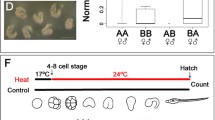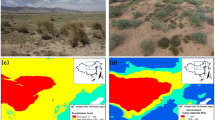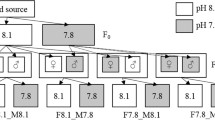Abstract
Environmental stress, such as acidification, can challenge persistence of natural populations and act as a powerful evolutionary force at ecological time scales. The ecological and evolutionary responses of natural populations to environmental stress at early life-stages are often mediated via maternal effects. During early life-stages, maternal effects commonly arise from egg coats (the extracellular structures surrounding the embryo), but the role of egg coats has rarely been studied in the context of adaptation to environmental stress. Previous studies on the moor frog Rana arvalis found that the egg coat mediated adaptive divergence along an acidification gradient in embryonic acid stress tolerance. However, the exact mechanisms underlying these adaptive maternal effects remain unknown. Here, we investigated the role of water balance and charge state (zeta potential) of egg jelly coats in embryonic adaptation to acid stress in three populations of R. arvalis. We found that acidic pH causes severe water loss in the egg jelly coat, but that jelly coats from an acid-adapted population retained more water than jelly coats from populations not adapted to acidity. Moreover, embryonic acid tolerance (survival at pH 4.0) correlated with both water loss and charge state of the jelly, indicating that negatively charged glycans influence jelly water balance and contribute to embryonic adaptation to acidity. These results indicate that egg coats can harbor extensive intra-specific variation, probably facilitated in part via strong selection on water balance and glycosylation status of egg jelly coats. These findings shed light on the molecular mechanisms of environmental stress tolerance and adaptive maternal effects.





Similar content being viewed by others
References
Andren C, Marden M, Nilsson G (1989) Tolerance to low pH in a population of moor frogs, Rana arvalis, from an acid and a neutral environment: a possible case of rapid evolutionary response to acidification. Oikos 56:215–223
Anthony KRN, Kline DI, Diaz-Pulido G, Dove S, Hoegh-Guldberg O (2008) Ocean acidification causes bleaching and productivity loss in coral reef builders. Proc Natl Acad Sci USA 105:17442–17446
APHA (1985) Standard methods for the examination of water and wastewater, vol 16. American Public Health Association, Washington, DC
Arranz SE, Albertali IE, Cabada MO (1997) Bufo arenarum egg jelly coat: purification and characterization of two highly glycosylated proteins. Biochem J 323:307–312
Azevedo LB, van Zelm R, Hendriks AJ, Bobbink R, Huijbregts MA (2013) Global assessment of the effects of terrestrial acidification on plant species richness. Environ Pollut 174:10–15
Bansil R, Stanley HE, Lamont JT (1995) Mucin biophysics. Annu Rev Physiol 57:635–657
Berner NJ, Ingermann RL (1990) Role of sialic acid in exogenous protein accumulation and water retention by the egg jelly of the Salamander Ambystoma macrcbdactylum. J Exp Zool 256:38–43
Berois N, Arezo MJ, Papa NG (2011) Gamete interactions in teleost fish: the egg envelope. Basic studies and perspectives as environmental biomonitor. Biol Res 44:119–124
Brunberg AK, Blomqvist P (2001) Quantification of anthropogenic threats to lakes in a lowland county of central Sweden. Ambio 30:127–134
Byrne M, Soars N, Selvakumaraswamy P, Dworjanyn SA, Davis AR (2010) Sea urchin fertilization in a warm, acidified and high pCO(2) ocean across a range of sperm densities. Mar Environ Res 69:234–239
Carroll EJ (1991) Structure and macromolecular-composition of the egg and embryo jelly coats of the anuran Lepidobatrachus laevis. Dev Growth Differ 33:37–43
Collier KJ, Ball OJ, Graesser AK, Main MR, Winterbourn MJ (1990) Do organic and anthropogenic acidity have similar effects on aquatic fauna? Oikos 59:33–38
Coppin A, Maes E, Flahaut C, Coddeville B, Strecker G (1999) Acquisition of species-specific O-linked carbohydrate chains from oviducal mucins in Rana arvalis—a case study. FEBS J 266:370–382
Dam HG (2013) Evolutionary adaptation of marine zooplankton to global change. Annu Rev Mar Sci 5:349–370
Derry AM, Arnott SE (2007) Adaptive reversals in acid tolerance in copepods from lakes recovering from historical stress. Ecol Appl 17:1116–1126
Doney SC, Fabry VJ, Feely RA, Kleypas JA (2009) Ocean acidification: the other CO2 problem. Annu Rev Mar Sci 1:169–192
Dunson WA, Connell J (1982) Specific-inhibition of hatching in amphibian embryos by low pH. J Herpetol 16:314–316
Egea-Serrano A, Hangartner S, Laurila A, Räsänen K (2014) Multifarious selection through environmental change: acidity and predator-mediated adaptive divergence in the moor frog (Rana arvalis). Proc R Soc Lond B 281:20133266
Evans TG, Chan F, Menge BA, Hofmann GE (2013) Transcriptomic responses to ocean acidification in larval sea urchins from a naturally variable pH environment. Mol Ecol 22:1609–1625
Findlay HS, Kendall MA, Spicer JI, Turley C, Widdicombe S (2008) Novel microcosm system for investigating the effects of elevated carbon dioxide and temperature on intertidal organisms. Aquat Biol 3:51–62
Gagneux P, Varki A (1999) Evolutionary considerations in relating oligosaccharide diversity to biological function. Glycobiology 9:747–755
Glandt D (2006) Der Moorfrosch—Einheit und Vielfalt einer Braunfroschart. Laurenti, Bielefeld
Gosner KL (1960) A simplified table for staging anuran embryos and larvae with notes on identification. Herpetologica 16:183–190
Gosner KL, Black IH (1957) The effects of acidity on the development and hatching of New-Jersey frogs. Ecology 38:256–262
Guerardel Y, Kol O, Maes E, Lefebvre T, Boilly B, Davril M, Strecker G (2000) O-glycan variability of egg-jelly mucins from Xenopus laevis: characterization of four phenotypes that differ by the terminal glycosylation of their mucins. Biochem J 352:449–463
Hangartner S, Laurila A, Räsänen K (2011) Adaptive divergence of the moor frog (Rana arvalis) along an acidification gradient. BMC Evol Biol 11:366
Hangartner S, Laurila A, Räsänen K (2012a) Adaptive divergence in moor frog (Rana Arvalis) populations along an acidification gradient: inferences from Qst-Fst correlations. Evolution 66:867–881
Hangartner S, Laurila A, Räsänen K (2012b) The quantitative genetic basis of adaptive divergence in the moor frog (Rana arvalis) and its implications for gene flow. J Evol Biol 25:1587–1599
Hedrick JL (2008) Anuran and pig egg zona pellucida glycoproteins in fertilization and early development. Int J Dev Biol 52:683–701
Hedrick J, Hardy D (1991) Chapter 12 Isolation of extracellular matrix structures from Xenopus laevis oocytes, eggs, and embryos. In: Kay BK, Peng HB (eds) Xenopus laevis: practical uses in cell and molecular biology, vol. 36. Acedemic, London 36, pp 231–247
Hedrick JL, Nishihara T (1991) Structure and function of the extracellular matrix of anuran eggs. J Electron Micr Tech 17:319–335
Herrler A, Beier HM (2000) Early embryonic coats: morphology, function, practical applications—an overview. Cells Tissues Organs 166:233–246
Hoffmann AA, Parsons PA (1997) Extreme environmental change and evolution. Cambridge University Press, Cambridge
Hoffmann AA, Sgrò CM (2011) Climate change and evolutionary adaptation. Nature 470:479–485
Honisch B, Ridgwell A, Schmidt DN, Thomas E, Gibbs SJ et al (2012) The geological record of ocean acidification. Science 335:1058–1063
Iglesias-Rodriguez MD, Halloran PR, Rickaby RE, Hall IR et al (2008) Phytoplankton calcification in a high CO2 world. Science 320:336–340
Jokiel PL, Rodgers KS, Kuffner IB, Andersson AJ, Cox EF, Mackenzie FT (2008) Ocean acidification and calcifying reef organisms: a mesocosm investigation. Coral Reefs 27:473–483
Kirby BJ, Hasselbrink EF (2004a) Zeta potential of microfluidic substrates: 1. Theory, experimental techniques, and effects on separations. Electrophoresis 25:187–202
Kirby BJ, Hasselbrink EF (2004b) Zeta potential of microfluidic substrates: 2. Data for polymers. Electrophoresis 25:203–213
Kosmulski M (2009) Surface charging and points of zero charge. CRC, Boca Raton
Kroeker KJ, Kordas RL, Crim RN, Singh GG (2010) Meta-analysis reveals negative yet variable effects of ocean acidification on marine organisms. Ecol Lett 13:1419–1434
Lee PA (1967) Studies of frog oviducal jelly secretion 2. Cytology of secretory cycle. J Exp Zool 166:107–119
Lohbeck KT, Riebesell U, Reusch TBH (2012) Adaptive evolution of a key phytoplankton species to ocean acidification. Nat Geosci 5:346–351
McNaught AD, Wilkinson A, International Union of Pure and Applied Chemistry (1997) Compendium of chemical terminology: IUPAC recommendations, 2nd edn. Blackwell, Oxford
Menkhorst E, Selwood L (2008) Vertebrate extracellular preovulatory and postovulatory egg coats. Biol Reprod 79:790–797
Merilä J, Söderman F, O’Hara R, Räsänen K, Laurila A (2004) Local adaptation and genetics of acid-stress tolerance in the moor frog, Rana arvalis. Conserv Genet 5:513–527
Millennium Ecosystem Assessment (2005) Ecosystems and human well-being. Synthesis Island Press, Washington, DC
Mousseau TA, Fox CW (eds) (1998) Maternal effects as adaptations. Oxford University Press, New York
Mullet M, Fievet P, Reggiani JC, Pagetti J (1997) Surface electrochemical properties of mixed oxide ceramic membranes: zeta-potential and surface charge density. J Membr Sci 123:255–265
Munday PL, Dixson DL, Donelson JM, Jones GP, Pratchett MS et al (2009) Ocean acidification impairs olfactory discrimination and homing ability of a marine fish. Proc Natl Acad Sci USA 106:1848–1852
Palumbi SR (2009) Speciation and the evolution of gamete recognition genes: pattern and process. Heredity 102:66–76
Patil S, Sandberg A, Heckert E, Self W, Seal S (2007) Protein adsorption and cellular uptake of cerium oxide nanoparticles as a function of zeta potential. Biomaterials 28:4600–4607
Persson M, Räsänen K, Laurila A, Merilä J (2007) Maternally determined adaptation to acidity in Rana arvalis: are laboratory and field estimates of embryonic stress tolerance congruent? Can J Zool 85:832–838
Pespeni MH, Sanford E, Gaylord B et al (2013) Evolutionary change during experimental ocean acidification. Proc Natl Acad Sci USA 110:6937–6942
Picker MD, Mckenzie CJ, Fielding P (1993) Embryonic tolerance of Xenopus (Anura) to acidic blackwater. Copeia 1993:1072–1081
Pierce BA (1985) Acid tolerance in amphibians. Bioscience 35:239–243
Räsänen K, Green DM (2009) Acidification and its effects on amphibian populations. In: Heatwole H (ed) Amphibian biology, vol. 8. Decline: diseases, parasites, maladies and pollution. Surrey Beatty, Chipping Norton, pp 3244–3267
Räsänen K, Kruuk LEB (2007) Maternal effects and evolution at ecological time-scales. Funct Ecol 21:408–421
Räsänen K, Laurila A, Merilä J (2003a) Geographic variation in acid stress tolerance of the moor frog Rana arvalis. I. Local adaptation. Evolution 57:352–362
Räsänen K, Laurila A, Merilä J (2003b) Geographic variation in acid stress tolerance of the moor frog, Rana arvalis. II. Adaptive maternal effects. Evolution 57:363–371
Räsänen K, Soderman F, Laurila A, Merilä J (2008) Geographic variation in maternal investment: acidity affects egg size and fecundity in Rana arvalis. Ecology 89:2553–2562
Renberg I, Korsman T, Anderson NJ (1993) A temporal perspective of lake acidification in Sweden. Ambio 22:264–271
Salthe SN (1963) The egg capsules in the Amphibia. J Morphol 113:161–171
Seip HM, Tollan A (1978) Acid precipitation and other possible sources for acidification of rivers and lakes. Sci Total Environ 10:253–270
Seymour RS (1994) Oxygen diffusion through the jelly capsules of amphibian eggs. Isrsel J Zool 40:493–506
Shu L (2014) The molecular basis of embryonic adaptation to acid stress in amphibians. PhD dissertation Nr. 22319, ETH Zürich, Zürich. doi:10.3929/ethz-a-010361827
Varki A (2011) Evolutionary forces shaping the golgi glycosylation machinery: why cell surface glycans are universal to living cells. Cold Spring Harb Perspect Biol 3 pii: a005462. doi:10.1101/cshperspect.a005462
Wong JL, Wessel GM (2006) Defending the zygote: search for the ancestral animal block to polyspermy. Curr Top Dev Biol 72:1–151
Yurewicz EC, Oliphant G, Hedrick JL (1975) Macromolecular composition of Xenopus laevis egg jelly coat. Biochemistry 14:3101–3107
Acknowledgments
We thank Beatrice Lindgren for invaluable help with the field and laboratory work, Baptiste Pasteur for help in collecting the frogs, and Yang Yue for help with the zeta potential measurement. The experiments were conducted under permissions from the Västra Götaland county board and the Ethical committee for animal experiments in Uppsala County. This study was supported by Swiss National Science foundation (to K.R.).
Conflict of interest
The authors declare that they have no competing interests.
Author information
Authors and Affiliations
Corresponding author
Additional information
Communicated by William J. Resetarits.
Research highlight:
This research increases our understanding of the ecological and evolutionary role of egg coats, which are maternally derived extracellular structures that surround the organism during early life stages. This study revealed that acid stress could cause severe water loss of egg jelly and likely imposed strong selection on water balance of egg jelly in amphibians by reduced embryonic hatching success. In addition, this study suggested that a “pH-jelly water balance” model, mediated via intra-specific glycan variability, may help explaining the molecular basis of embryonic adaptation to acid stress and egg-coat mediated adaptive maternal effects. Moreover, this model can be extended to other aquatic systems in both vertebrate and invertebrate taxa.
Electronic supplementary material
Below is the link to the electronic supplementary material.
Rights and permissions
About this article
Cite this article
Shu, L., Suter, M.JF., Laurila, A. et al. Mechanistic basis of adaptive maternal effects: egg jelly water balance mediates embryonic adaptation to acidity in Rana arvalis . Oecologia 179, 617–628 (2015). https://doi.org/10.1007/s00442-015-3332-4
Received:
Accepted:
Published:
Issue Date:
DOI: https://doi.org/10.1007/s00442-015-3332-4




